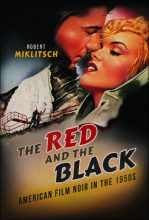Film noir in the 1950s is a very special period in the genre‘s/style’s history, since for some experts film noir ended just then, while for others it almost died then and had finally vanished completely in the early 1960s. (To resurface as neo-noir in the early 1980s).
 In the resent book the author tries to describe American film noir of the 1950s when the genre underwent several alterations, some due to the social climate, others to the spread of TV sets in US households, a changing studio system, new equipment that allowed portable devices and outside shots, color productions or direct reaction to current political changes.
In the resent book the author tries to describe American film noir of the 1950s when the genre underwent several alterations, some due to the social climate, others to the spread of TV sets in US households, a changing studio system, new equipment that allowed portable devices and outside shots, color productions or direct reaction to current political changes.
Miklitsch, a professor in the department of English language and literature at Ohio University, divides his survey into three parts, consisting of the themes anticommunism and red menace, “atomic noir,” and the new technologies/media.
One of his main claims after going into very detailed investigations of a few classic noirs and some rather unknown pictures: film noir in the 1950s is a very special artifact.
What may come as a surprise to some readers and fans, (some excellent) movies were not restricted to black and white film material. There are in fact color noirs, or film “noir in color,” so to speak. Miklitsch goes into deep analysis of a few of them such as Black Widow (1954), House of Bamboo (1955), Slightly Scarlet and A Kiss Before Dying (both from 1956) in part three “Noir en couleur: Color and Widescreen” of the book, what is probably the best section of the volume.
Color film and new technical gadgets (3D, 4 track sound) altered not just production but also presented new stereotypical noir types. As “….film noir in 1945 was wedded to black-and-white a practice reiterated in the genre’s stereotypical, black-and-white representation of women as either ‘good’ or ‘bad girls,’….” argues Miklitsch. “By 1953, though, color was beginning to replace monochrome in the motion picture industry even as the Kinsey Report was challenging prevailing attitudes about female fantasy and sexuality.”
The Red and the Black clearly denies the often-made statement that the genre vanished in the 1950s. Instead, Miklitsch argues that the new technologies and new subjects and themes were used to emphasize certain important statistical aspects of the 1940s noir style, while some new characteristics – as the use of certain colors and extra lighting – simply added more varieties for the director.
An interesting piece of work that highlights a commonly neglected period of American film noir.
Review by Dr. A. Ebert © 2017
Robert Miklitsch. The Red and the Black: American Film Noir in the 1950s. University Press of Illinois, 2017, 312 p.
